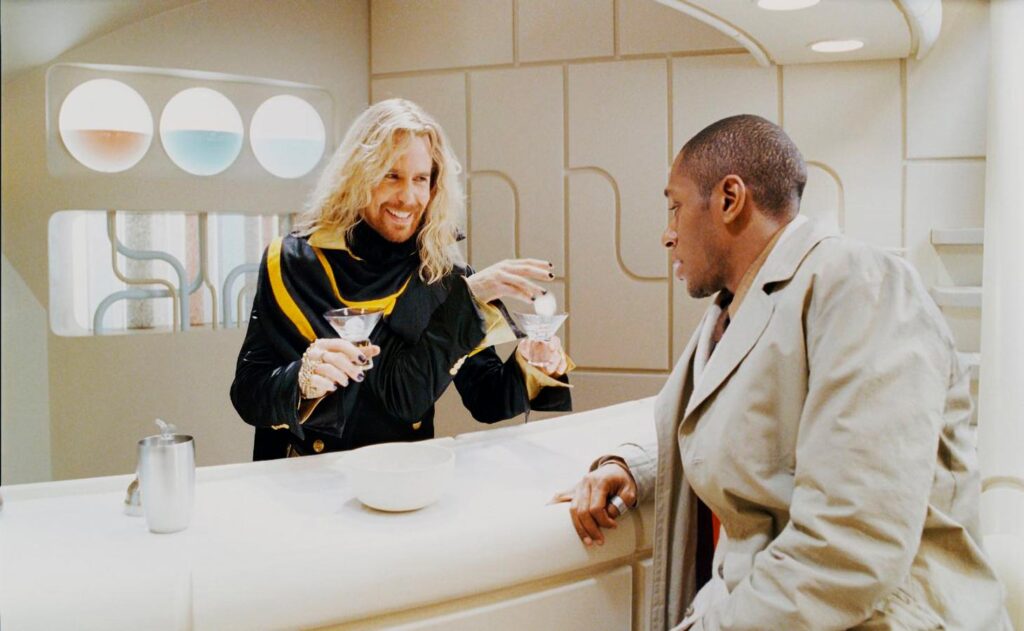Let’s talk jobs. Some people go to work, follow the tasks laid out each day, and go home. For other people—like the marketing teams we all know and love—days have a general format that tends to fall off the beaten track soon after that mocha latte is sucked down.
If you’re working in development, it’s a weird thing. We have those typical 40-hour weeks sometimes, with days when other challenges are thrown in for good measure. And then, there are periods when everything we know turns into controlled chaos.
This is a small slice of life in Stax Bill’s development team.
Sometimes we’re all moving in the same direction. Other times we’re split into smaller groups, and we have to move together quite cohesively to get things done. Done right, and done fast. We’ve had some amazing launches, such as our integrations with powerhouses like SalesForce, NetSuite, QuickBooks, and others.
“Don’t Panic.”
And then, in walked Greg Burwell, our CTO. Were his plans to shake things up with his next mission? You betcha. Greg threw out a new challenge.
Let’s develop an integration with HubSpot, Greg said. It’ll be fun. At this point, we all started to default to a reality-based version of Hitchhikers Guide to the Galaxy, mentally preparing to leave the world as we knew it as Greg whisked us off to this next assignment, in Ford Prefect fashion.
He then assembled a dev team to take on the integration. For the most part, this team consisted of David Larkin, Jamie Munro, and Drew Gascoigne—all software engineers here at Stax Bill. Then came Steven Kennedy, a software development manager. And trying—and mostly succeeding—to keep things on the up and up was none other than our quality assurance specialist, Guy Thomas.
To be honest, we were all pretty excited, knowing that HubSpot is a leading software developer for inbound marketing and sales. Being able to collaborate with its team is pretty darn amazing.
“I was created to fulfill a function and I failed in it. I negated my own existence.”
Of course, we all know things are often easier said than done.
Case in point: in the early 1990s, FoxMeyer—then the fifth largest drug wholesaler in the United States—attempted to beat out competitors by integrating with an enterprise resource planning (ERP) system. After spending more than $100 million on the integration, poor planning and worse implementation resulted in disaster.
Boom. Bankruptcy.
As Hitchhiker’s computer Deep Thought said so eloquently: “I think the problem, to be quite honest with you, is that you’ve never actually known what the question is.”
Sure, we’d done integrations before at Stax Bill, but no two integrations are identical. Doing it right takes a lot of hard work and a high level of knowledge of the connected product. We needed to know what questions to ask first.
HubSpot is a really interesting platform to team up with. The business’s founders, Brian Halligan and Dharmesh Shah, started the company after noting a change in the way customers shopped and made purchases.
They realized customers no longer responded to strong-arm sales tactics; instead, they demanded a more customer-centric approach.
And HubSpot was ready to facilitate that change. In fact, in nearly two decades of steady growth, HubSpot has earned over 64,000 customers in more than 100 countries.
“The Babel fish is small, yellow, leech-like, and probably the oddest thing in the Universe.”
But how did HubSpot customers actually use the platform? We needed to insert our Babel fish and learn the language of HubSpot. By this, I mean we dove headfirst into the HubSpot application and really gathered in-depth knowledge of the CRM, or customer relationship management platform.
A significant challenge our team faced was to explore and fully understand the ‘contacts’ features on HubSpot’s platform. This was because—at the time—there were no flexible billing capabilities. Nor was there any subscription functionality. So, what would happen if a user through one of HubSpot’s customers wanted to make a change to their subscription?
Yeah, that could be a problem.
With this in mind, we needed a baseline. First, we ran an initial test with a limited functionality, pushed out an invoice, and added a financial dimension to HubSpot.
Armed with the answers to this test, we took a deep breath and caught a ride to HubSpot’s mothership to demonstrate our findings.
“If there’s anything more important than my ego on this ship, I want it caught and shot right now.”
Leadership approval was just the beginning, though. Now the real work had to start, and we needed to get down to business. Our team knew we could build on our knowledge from integrating with Salesforce. We could undoubtedly replicate those successes, but there was a whole other can of worms with a HubSpot integration.
While there were more complexities, we needed to keep things simple in order to give customers a positive experience. If we didn’t do that, it would be a fast fail.
The question remained: how could Stax Bill offer complex billing functionality that would align with ease of use, customer interface, and the simplicity of HubSpot?
So, we finally had a project scope, some background experience, and a lot of unknowns.
We started whittling out the features we didn’t think were important for the HubSpot integration, which helped a lot. And in this case, we had a lot of leverage as far as design. But as long as we got the quote-to-cash process down, that was the main requirement.
After we designed our integration with HubSpot, it was really easy to execute. HubSpot had clearly defined patterns how to execute our plan with a solid UI design pattern. Head down and go– without any ‘how do I do this’.
Jamie Munro, Software Developer

“This time it was right, it would work, and no one would have to get nailed to anything.”
And as soon as we were clear on the deliverables at a high level, we worked together to sort out the details of the work.
In this case, it goes back to the adage that a bad dress rehearsal makes a good opening night. It was admittedly messy from the development side of Stax Bill. But it was okay to get messy before the hands-on keyboard part of the process started.
In fact, it was almost a necessary step since it was important to get the full understanding and the full plan before starting coding.
“The most enjoyable part of working on the HubSpot integration was their great documentation, they have clearly defined UX patterns, and their API reference was very complete. When starting to work on a new integration that is really all you can hope for!”
Drew Gascoigne, Software Engineer

And while there wasn’t any threat of a planet blowing up, the timeline was pretty rigorous. We knew competitors were trying to accomplish similar integrations. We not only wanted to be first out of the gate, but also we wanted to get it right the first time.
It was refreshing to focus on making agents’ work easier rather than just synchronizing data for “reasons”.
Steve Kennedy, Software Development Manager

And it wasn’t all fun and games.
Remember Hitchhiker’s Infinite Improbability Drive? Yeah, that’s where we were for a time: “Two to the power of 600,000 to one against, and falling…”
In enters the bug. Fortunately, not a Ravenous Bugblatter Beast of Traal, because this story would not have ended so well. But our bug was in Chrome that took some time to circumnavigate. And sure, because that wasn’t enough, we decided we needed to bring in a third-party software company to provide a mockup for rapid deployment within HubSpot.
Frankly, it makes one’s mind hurt just to think of it.
It took three months to complete the integration, including six weeks of programming. But in the end, we were able to see Greg Burwell’s challenge to completion, and sent the final product to HubSpot’s lead designer.
We didn’t have to wait long before they went over the final product.
Was it perfect? Close… There was some feedback on items that needed to be polished. But seeing the quality of the HubSpot programming documentation, our dev team knew that feedback was, indeed, quality information.
Any ‘special project’ has a different feel to regularly-scheduled dev work, so it’s kind of nice to do stuff occasionally to break up the regular flow. Having a group brainstorming session helps with the creativity. Also, it helps that our integration really has the look and feel of HubSpot. Having something so crisp and clean feels pretty nice.
Guy Thomas, QA Specialist

With Stax Bill’s HubSpot integration, users can now remain on the HubSpot platform, while also:
- configuring subscription plans, prices, and changes
- generating invoices
- managing recurring payments, and
- enjoying an enhanced HubSpot customer experience.
Pretty sweet, if we do say so ourselves.
Workflows over features; that was the tenet we built upon.
Dave Larkin, Senior Developer

“So long and thanks for all the fish.”
With a successful HubSpot integration launched, we’re already looking forward to future projects.
In fact, the agility Stax Bill’s platform provides will continue to be a guiding force in the future. How can we deliver that flexibility in upcoming integrations without making the process overwhelming for the end user?
The answer, we know, is to become familiar with how the user gets the most value out of the system. Flexible but not overwhelming is the goal, they said. That in itself is a fine balance.
Is this the end of the story for the Stax Bill-HubSpot integration? Hopefully not. Now, we’re looking forward to hearing from customers. So far, the feedback has been quite positive, but we’re always looking for ways to keep building on the success of this integration, and prepare for the next assignment. After all, we’re always moving on to our next great mission.
Meanwhile, we’ll keep mulling over the Answer to the Ultimate Question of Life, the Universe, and Everything.
42. Over and out.







